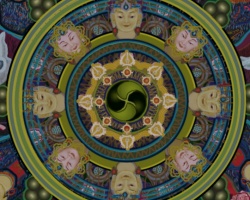Difference between revisions of "Causality of Past and Present Sutra"
(Created page with "thumb|250px| <poem> Causality of Past and Present Sutra 過去現在因果経 (Chin Kuo-ch’y-hsien-tsai-yin-kuo-ching; Jpn Kako-gen...") |
|||
| Line 4: | Line 4: | ||
[[Causality of Past and Present Sutra]] | [[Causality of Past and Present Sutra]] | ||
| − | [[過去現在因果経]] (Chin [[Kuo-ch’y-hsien-tsai-yin-kuo-ching]]; Jpn [[Kako-genzai-inga-kyo]] ) | + | [[過去現在因果経]] ([[Chin]] [[Kuo-ch’y-hsien-tsai-yin-kuo-ching]]; Jpn [[Kako-genzai-inga-kyo]] ) |
| − | Also known as the [[Causality Sutra]]. A [[sutra]] translated from [[Sanskrit]] into {{Wiki|Chinese}} in the mid-fifth century by [[Gunabhadra]], a [[monk]] from central India.It is set in [[Jetavana Monastery]] in [[Shravasti]], [[India]], and takes the [[form]] of an account by [[Shakyamuni Buddha]] of his own past.He tells of his practice in a past [[existence]] as a seer named Good [[Wisdom]], explaining that he obtained the [[supreme wisdom]] in this [[life]] as a result of performing [[bodhisattva]] austerities in the past.The [[sutra]] then describes his passage through the eight phases of a [[Buddha's]] [[existence]], or successive phases [[manifested]] by a [[Buddha]] for the purpose of saving all people.Its {{Wiki|literary}} [[merit]] makes the [[sutra]] outstanding among the {{Wiki|biographies}} of the [[Buddha]] translated into Chinese.This [[sutra]] became popular in [[China]] and [[Japan]], and in [[Japan]] was published with illustrations.See also eight phases of a [[Buddha's]] [[existence]]. | + | Also known as the [[Causality Sutra]]. A [[sutra]] translated from [[Sanskrit]] into {{Wiki|Chinese}} in the mid-fifth century by [[Gunabhadra]], a [[monk]] from central India.It is set in [[Jetavana Monastery]] in [[Shravasti]], [[India]], and takes the [[form]] of an account by [[Shakyamuni Buddha]] of his [[own]] past.He tells of his practice in a {{Wiki|past}} [[existence]] as a [[seer]] named Good [[Wisdom]], explaining that he obtained the [[supreme wisdom]] in this [[life]] as a result of performing [[bodhisattva]] austerities in the past.The [[sutra]] then describes his passage through the eight phases of a [[Buddha's]] [[existence]], or successive phases [[manifested]] by a [[Buddha]] for the {{Wiki|purpose}} of saving all people.Its {{Wiki|literary}} [[merit]] makes the [[sutra]] outstanding among the {{Wiki|biographies}} of the [[Buddha]] translated into Chinese.This [[sutra]] became popular in [[China]] and [[Japan]], and in [[Japan]] was published with illustrations.See also eight phases of a [[Buddha's]] [[existence]]. |
</poem> | </poem> | ||
{{R}} | {{R}} | ||
[http://www.sgilibrary.org/search_dict.php?id=251 www.sgilibrary.org] | [http://www.sgilibrary.org/search_dict.php?id=251 www.sgilibrary.org] | ||
[[Category:Sutras]] | [[Category:Sutras]] | ||
Latest revision as of 18:44, 22 February 2015
Causality of Past and Present Sutra
過去現在因果経 (Chin Kuo-ch’y-hsien-tsai-yin-kuo-ching; Jpn Kako-genzai-inga-kyo )
Also known as the Causality Sutra. A sutra translated from Sanskrit into Chinese in the mid-fifth century by Gunabhadra, a monk from central India.It is set in Jetavana Monastery in Shravasti, India, and takes the form of an account by Shakyamuni Buddha of his own past.He tells of his practice in a past existence as a seer named Good Wisdom, explaining that he obtained the supreme wisdom in this life as a result of performing bodhisattva austerities in the past.The sutra then describes his passage through the eight phases of a Buddha's existence, or successive phases manifested by a Buddha for the purpose of saving all people.Its literary merit makes the sutra outstanding among the biographies of the Buddha translated into Chinese.This sutra became popular in China and Japan, and in Japan was published with illustrations.See also eight phases of a Buddha's existence.
